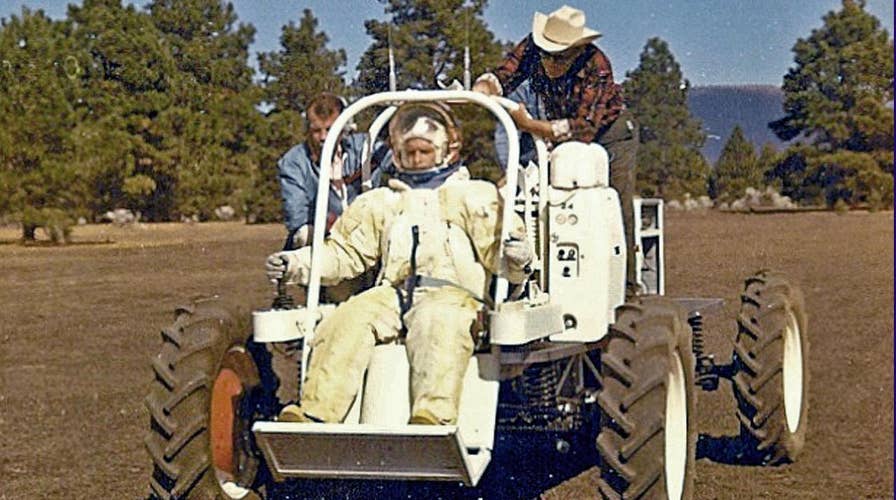NASA lunar legacy in the Arizona desert
With July 2019 being the 50th anniversary of the moon landing, scientists, researchers, and astronomers continue legacy in Flagstaff.
FLAGSTAFF, Ariz. -- When people think about space missions and moon landings, it's usually Cape Canaveral, Fla., and Houston, Texas, that comes to mind.
But this Arizona city has also played a critical role in space exploration. It’s where NASA trained all its Apollo astronauts before setting foot on the moon and it’s where professors, scientists, astronauts and astronomers are still conducting moon and space research for NASA today.
“It's very exciting to be celebrating the 50th anniversary of the Apollo 11 landings but that work hasn't stopped,” said Laszlo Kestay, a research geologist for the U.S. Geological Survey.
The city has spent the last year celebrating its place in lunar landing history. There have been more than 100 events and astronaut meet-and-greets.
CLICK HERE TO GET THE FOX NEWS APP
It's not widely known, but Flagstaff still plays an important role in understanding the moon. In this mountainous pine forest section of the desert, Nadine Barlow, a space grant director for NASA and Northern Arizona University, is researching where the best location would be for humans to live on the moon.
BUZZ ALDRIN, OTHERS TELL APOLLO'S INSIDE STORY IN RARE, NEWLY RELEASED INTERVIEWS
“There actually is talk of sending humans and establishing a base in perhaps the largest impact basin on the surface of the moon, which is called the South Pole Aiken Basin,” Barlow said. “It’s located near the South Pole (of the moon). It’s a very, very large impact basin.”

One of the crater fields for training astronauts, this one located at the southeast corner of the Cinder Lake Landfill...picture taken March 2019 (Danielle Adams, Lowell Observatory)
Barlow said there is a Chinese rover in that location feeding information back to them about a “possible landing site.” The base would house scientists, engineers, and -- depending on how long-term the base would be -- doctors and farmers.
When Apollo astronauts stepped foot on the moon, they also brought back rock and soil samples with them that is still being researched today. Barlow said scientists continue to get a “better understating (of) the geological history of the moon.”
“We kind of have this broad sweep of what we believe the moon has actually gone through to look like what it is today but now we're starting to get new data sets, higher resolution data, some new information that is making us pause and say 'well, maybe this broad paintbrush of the moon is not exactly accurate,'” Barlow said.
Scientists originally thought the moon was dry but that view has changed.

Aerial photo of detonations to make Crater Field 2 (U.S. Geological Survey, Department of the Interior/USGS)
“More recent studies are showing that the moon actually does have some volatiles like water in certain locations," Barlow said. "And so we're reconsidering…we're having to look at more of the details in terms of how exactly can you do that without getting rid of all the volatiles during such an impact.”
The U.S. Geological Survey was instrumental in bringing NASA to Flagstaff over 50 years ago.

Photo of Patricia Bridges, one of the artists who created airbrushed lunar maps at the ACIC (Aeronautical Chart and Information Center) housed at Lowell Observatory (Lowell Observatory)
One of the projects that scientists in Arizona are now working on is mapping out landing sites for a nuclear-powered drone to fly in the atmosphere of Titan, the largest moon of Saturn.
APOLLO 11'S MICHAEL COLLINS REFLECTS ON HISTORIC MOON LANDING: 'WE WERE JUST REGULAR ASTRONAUTS'
“The whole idea of having a vehicle robotically flying around on the moon of another planet—it's a wild mission,” Kestay said.

Gordon Swann in suit holding Apollo Lunar Staff prototype; tool carrier in front (USGS)
NASA came to Flagstaff because it could provide the agency with a nearby meteor crater, along with desolate, volcanic land that could serve as a virtual replica of the moon's surface.
In fields surrounding the city, the USGS made mock craters to resemble the moon’s surface by exploding holes in fields. There, Apollo astronauts trained to get a first-hand simulated lunar surface experience before setting foot on the moon.

Lowell Observatory telescope used by scientists who collaborated with artists to map out the moon for Apollo astronauts (Fox News)
Astronauts are still taken to those locations to see what it was like for the Apollo astronauts and to find inspiration.
Barlow said it's still an exciting time for space exploration.
“I can remember as a kid sitting there watching Neil Armstrong take the first step on the surface of the moon," Barlow said. "To actually be part of this next generation and the scientific exploration of the moon and preparing for humans to go back to the moon and on to Mars and elsewhere in the solar system -- it's a very exciting time.”

